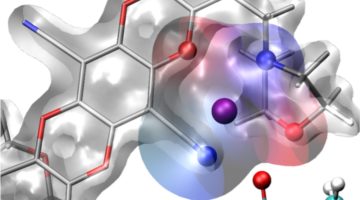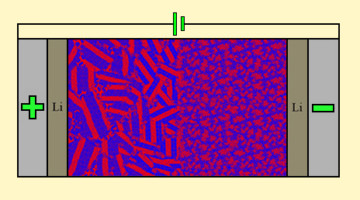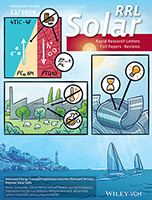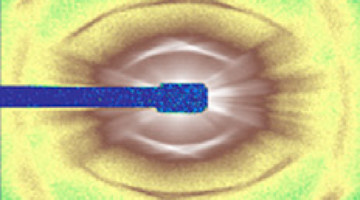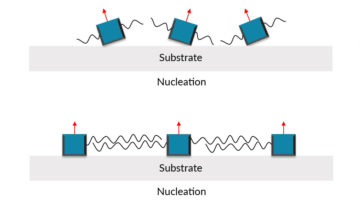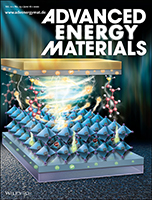Researchers designed a polymer membrane with molecular cages built into its pores that hold positively charged ions from a lithium salt. These “solvation cages” increased lithium-ion flow by an order of magnitude and could allow high-voltage battery cells to operate at higher power and more efficiently, important for both electric vehicles and aircraft. Read more »
Probing Composite Materials to Make Better Batteries
Researchers found that when an ion-conducting polymer composite is placed in an electric field, it forms ion-rich hotspots that continue to grow for hours after the field is removed. The study opens a new path to understanding the dynamic structure of composite materials for smaller, lighter batteries. Read more »![]()
![]()
Stacking the Deck for Custom-Built Hybrid Materials
Researchers fabricated an electronically coupled heterostructure from a novel semiconducting 2D polymer and a 2D transition metal dichalcogenide. Dramatic optical and electronic changes emerged as polymer thickness decreased, underscoring the potential for the discovery of emergent phenomena in studies of hybrid heterostructures. Read more »
Functionalization of Benzotriazole-Based Conjugated Polymers for Solar Cells: Heteroatom vs Substituents
Understanding the structure-property relationship is important when designing new conjugated polymers for high-efficiency polymer solar cells. Rech et al. systematically explore the impact of a variety of functional groups, including nitrogen heteroatoms, fluorine substituents, and cyano groups. Read more »
Balanced Charge Transport Optimizes Industry‐Relevant Ternary Polymer Solar Cells
In this article, Szymanski et al. develop novel, cost‐effective ternary polymer solar cells printed in semi‐industrial conditions from a relatively benign ink, which do not require any further processing. These solar cells show good stability and efficiency due to balanced charge-carrier mobilities achieved by optimizing the composition and morphology. Read more »
Toughening Mechanisms in Carp Scales at the Nanoscale
Scientists have characterized carp scales down to the nanoscale, using the ALS to watch how the fibers in the scales react as stress is applied. The resulting insights provide inspiration for the design of advanced synthetic structural materials with unprecedented toughness and penetration resistance. Read more »![]()
![]()
Thermoinduced Crystallization-Driven Self-Assembly of Bioinspired Block Copolymers in Aqueous Solution
Thermoinduced crystallization-driven self-assembly of polypeptoid-based block copolymers results in delicate control over the nanostructure in aqueous solution. This provides a convenient platform for comparing cellular uptake efficiency of nanostructured assemblies with various morphologies that are otherwise similar. Read more »
Long Chains Stabilize Higher-Efficiency Solar Cells
Perovskite thin films have many attractive properties for use in photovoltaics, but their assembly into practical devices has led to trade-offs between efficiency and stability. The addition of surfactant-type molecules with hydrophobic chains helped produce perovskite solar cells that are both efficient and stable. Read more »
Off the Scales: Fish Armor Both Tough and Flexible
Humans have drawn technological inspiration from fish scales going back to ancient times: Romans, Egyptians, and other civilizations would dress their warriors in scale armor, providing both protection and mobility. Now, scientists have characterized carp scales down to the nanoscale, enabling them to understand how the material is resistant to penetration while retaining flexibility. Read more »
Energetics and Energy Loss in 2D Ruddlesden–Popper Perovskite Solar Cells
Qinye Bao and co‐workers systematically investigate the energetics and energy loss in 2D Ruddlesden‐Popper perovskite (RPP) solar cells. The crucial scenario found at the 2D RPP/electron transport layer interface is that the potential gradient across ligands promotes separation of the photogenerated carrier, with electrons transferring from the perovskite crystal to the electron transport layer. Read more »
- « Previous Page
- 1
- 2
- 3
- 4
- 5
- …
- 7
- Next Page »
